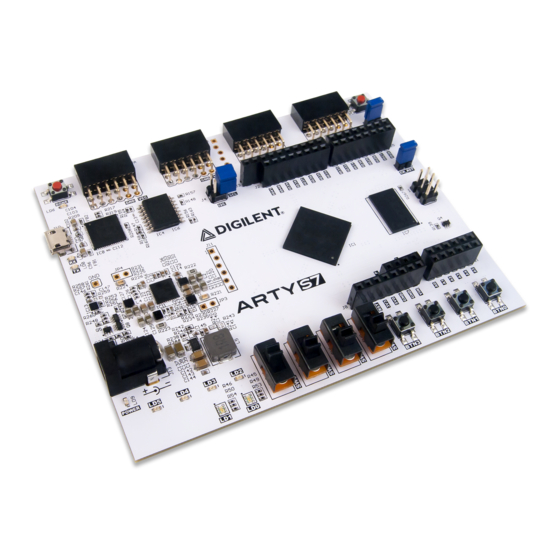Digilent Arty S7 Referans Kılavuzu - Sayfa 11
Anakart Digilent Arty S7 için çevrimiçi göz atın veya pdf Referans Kılavuzu indirin. Digilent Arty S7 14 sayfaları.

Pin 9
Pin 10
Table 8.1. Arty S7 Pmod Pinout.
8.1 Standard Pmod
The standard Pmod connectors are connected to the FPGA via 200 Ohm series resistors. The series resistors prevent short circuits that can occur if the user accidentally drives a signal
that is supposed to be used as an input. The downside to this added protection is that these resistors can limit the maximum switching speed of the data signals. If the Pmod being used
does not require high-speed access, then the standard Pmod connector should be used to help prevent damage to the devices.
8.2 High-Speed Pmod
The High-speed Pmods use the standard Pmod connector, but have their data signals routed as impedance matched differential pairs for maximum switching speeds. They have pads
for loading resistors for added protection, but the Arty S7 ships with these loaded as 0-Ohm shunts. With the series resistors shunted, these Pmods offer no protection against short
circuits, but allow for much faster switching speeds. The signals are paired to the adjacent signals in the same row: pins 1 and 2, pins 3 and 4, pins 7 and 8, and pins 9 and 10.
Traces are routed 100 ohm (+/- 10%) differential.
These connectors should be used only when high speed differential signaling is required or the other Pmods are all occupied. If used as single-ended, coupled pairs may have significant
crosstalk. In applications where this is a concern, the standard Pmod connector shall be used. Another option would be to ground one of the signals (drive it low from the FPGA) and
use its pair for the signal-ended signal.
Since the High-Speed Pmods have 0-ohm shunts instead of protection resistors, the operator must take precaution to ensure that they do not cause any shorts.
9 Arduino/chipKIT Shield Connector
The Arty S7 can be connected to standard Arduino and chipKIT shields to add extended functionality. Special care was taken while designing the Arty S7 to make sure it is compatible
with the majority of Arduino and chipKIT shields on the market. The shield connector has 45 pins connected to the FPGA for general purpose Digital I/O. Due to the flexibility of
FPGAs, it is possible to use these pins for just about anything including digital read/write, SPI connections, UART connections, I2C connections, and PWM. Six of these pins (labeled
AN0-AN5) can also be used as single-ended analog inputs with an input range of 0V-3.3V, and another four (labeled AN6-9) can be used as differential analog input pairs with an input
range of 0V-1.0V.
Note: The Arty S7 is not compatible with shields that output 5V digital or analog signals. Driving pins on the Arty S7 shield connector above 5V may cause damage to
the FPGA.
Figure 9.1 diagrams the pins found on the shield connector of the Arty S7.
(https://reference.digilentinc.com/_media/arty/arty_shield_pins.png)
Pin Name
Shield Function
IO0-IO9, A
General purpose I/O
(IO42), A10-A11
pins
IO26-IO33
General purpose I/O
pins
IO34-IO41
General purpose I/O
pins
SCL
I2C Clock
Pmod JA
M18
N18
Figure 9.1. Shield connector pin diagram.
Arty S7 Connection
See Section titled "Shield Digital I/O"
See Section titled "Shield Digital I/O"
See Section titled "Shield Digital I/O"
See Section titled "Shield Digital I/O"
Pmod JB
N15
P16
Pmod JC
Pmod JD
R13
T11
V14
U11
Shared
Connections
–
Pmod JD
Pmod JC
–
